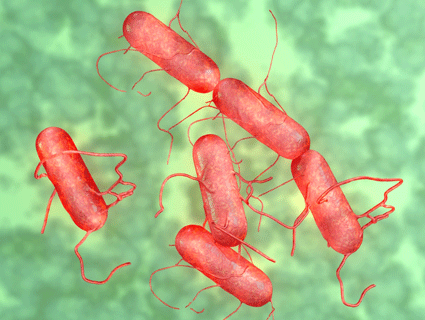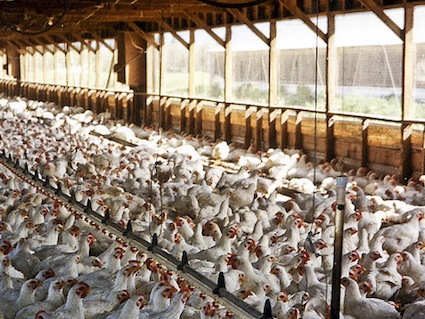
Salmonella bacteria<p><a href="http://www.shutterstock.com/cat.mhtml?lang=en&search_source=search_form&search_tracking_id=edc56NowTUv3z9JMqOA-TQ&version=llv1&anyorall=all&safesearch=1&searchterm=salmonella&search_group=&orient=&search_cat=&searchtermx=&photographer_name=&people_gender=&people_age=&people_ethnicity=&people_number=&commercial_ok=&color=&show_color_wheel=1" target="_blank">MichaelTaylor3d</a>/shutterstock</p>
Nothing like a big, multi-state salmonella outbreak to focus the mind of a federal government partially shut down by a political crisis. The Centers for Disease Control and Prevention (CDC), which gathers and analyzes data on such outbreaks and helps bring them under control, was effectively crippled in that capacity by the shutdown fiasco heading into this week, as Wired‘s Maryn McKenna reported.
But then on Monday, the US Department of Agriculture announced that 278 people across 18 states had been sickened by salmonella from eating chicken from a West Coast poultry processor called Foster Farms. And now the CDC’s outbreak-tracking team has been called back into action, Barbara Reynolds, a spokesperson for CDC, told me. Because the center had been monitoring the outbreak before the furloughs and snapped back into action after the USDA’s announcement Monday, the shutdown’s effect on CDC’s investigation had been “minimal,” she said.
And now that CDC team is back up and running, it has released fresh information about the outbreak, and the news is disturbing. About 42 percent of the people infected have had to be hospitalized—about double the normal rate, Reynolds said, meaning that the salmonella strains in the chicken seem to be virulent. Worse, the strain is “resistant to several commonly prescribed antibiotics,” CDC reports. And that means “an increased risk of hospitalization or possible treatment failure in infected individuals.” “Treatment failure,” of course, is another way of saying death.
As for the Agriculture Department’s Food Safety and Inspection Service, which inspects poultry plants and investigates them when an outbreak occurs, “the shutdown has not had an impact on this investigation,” USDA spokesman Aaron Lavallee told me. All the employees that inspect meat plants are considered essential and exempt from furloughs.
Dan Engeljohn, who directs the USDA’s meat plant inspections, said that the agency began collecting samples from Foster Farms facilities on the suspicion that they were the source of the outbreak on September 9, a process that continued until September 27. By Monday, October 7, when the USDA made its announcement, the agency had finished its lab analyses and determined that the outbreak strain had emerged from three Foster Farms facilities.
When it issued the announcement Monday morning, it also gave Foster Farms 72 hours to deliver a plan to show how it planned to resolve the salmonella problem in the three plants, Engeljohn said. The USDA will then assesses whether the plan is sufficient; if not, the agency will pull its inspectors from the three plants and effectively shut down their operation, he added.
Foster Farms was responsible for another salmonella outbreak, this one peaking in 2012, that sickened 134 people in 13 states. Engeljohn said that outbreak stemmed from different plants—in Washington state and not in California—and involved a different strain of salmonella.
Curious about the antibiotic-resistant nature of the current strain—again, it’s “resistant to several commonly prescribed antibiotics”—I checked Foster Farms’ website to see if the company had a policy on the controversial practice of feeding drugs to livestock. I found this:
Foster Farms has always prioritized the care and well-being of its birds and does not use antibiotics for the purpose of growth promotion. Any antibiotics used by Foster Farms for treatment are approved by the USDA and FDA for use in poultry and are prescribed by and monitored under the supervision of a veterinarian. Foster Farms observes all regulated antibiotic withdrawal times prior to processing.
Interestingly, that policy jibes perfectly with the Food and Drug Administration’s April 2012 “voluntary guidance” on antibiotics in meat animals, which urges producers to use antibiotics only to treat or prevent disease under the control of a veterinarian, and not to use them to make animals grow faster.
But as I argued at the time, by allowing the industry to use antibiotics to “prevent” disease, the guidance leaves a gaping loophole. As I wrote:
[H]ow can anyone distinguish giving animals small daily doses of antibiotics to prevent disease from giving them small daily doses to promote growth? The industry can simply claim it’s using antibiotics preventively and go on about its business—continuing to reap the benefits of growth promotion and continuing to menace public health by breeding resistance.













